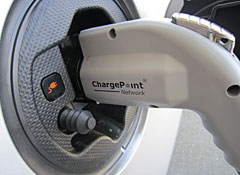
The one Prius every hardcore green-car enthusiast has been waiting for, the Prius plug-in hybrid, has finally arrived at dealerships. And we just took delivery of ours.
The Prius hybrid seemed such a natural for additional electric-only capability that aftermarket plug-in conversions have been available for at least five years. In fact, we had our previous-generation Prius converted back in 2008. Now, at last, Toyota is offering its own, bona fide in-house plug-in version. We've also driven its precursor, Toyota's experimental Prius plug-in back in 2010.
Prices start at $32,000 for the factory-built plug in, as opposed to $25,565 for a comparable regular Prius. The Advanced trim line model we bought featured a pre-collision system, navigation, and a power driver seat. The sticker price came to $40,285—a $9,720 premium over the highest trim conventional Prius. That's comparable to what you'd pay for a Chevrolet Volt, but the federal tax credit for the Prius plug-in is only $2,500, as opposed to $7,500 for the Volt and other pure EVs. It does qualify for driving in HOV (High Occupancy Vehicle) lanes, as do other hybrids, in some areas. So far, it's available only in 14 mostly Northeastern and West Coast states.
 The plug-in version uses a lithium-ion battery in place of the Prius's regular nickel-metal hydride battery. The plug-in is designed to run as a pure electric for 11 miles and then revert to regular Prius operation, which combines electric and gas operation. But if you thought you'd be using electricity exclusively for 11 miles, you'd soon discover that's not the case. As soon as you press the throttle farther than about a third of its travel, the internal combustion engine kicks in and you're using fuel. So, unlike the Volt, the Prius plug-in is never an unequivocal EV, even for the portion that's supposed to be gas-free.
The plug-in version uses a lithium-ion battery in place of the Prius's regular nickel-metal hydride battery. The plug-in is designed to run as a pure electric for 11 miles and then revert to regular Prius operation, which combines electric and gas operation. But if you thought you'd be using electricity exclusively for 11 miles, you'd soon discover that's not the case. As soon as you press the throttle farther than about a third of its travel, the internal combustion engine kicks in and you're using fuel. So, unlike the Volt, the Prius plug-in is never an unequivocal EV, even for the portion that's supposed to be gas-free.
A button that displays HV-EV can lock out (reserve) the EV portion in case, say, you're on the highway and you want to save the EV driving for downtown. We've nudged the car up to 60 mph on electric propulsion alone as long as we kept a light touch on the throttle pedal. Braking and coasting creates regenerating power that racks up "credit" miles for EV use.
Charging takes an hour and a half using a 240-volt supply and three hours on 110 volts, according to Toyota. We haven't established a pattern yet, but as soon as we start commuting in it regularly we'll report what we find. The EPA rates the Prius plug-in at 95 mpg equivalent in its electric mode and 50 mpg once it operates as a regular hybrid. That works out to some 2.8 miles per kilowatt hour of electricity in the EPA's method of reckoning, which is about par for the course among electric vehicles to date.
Other than the added purchase price, trade offs for the plug-in include the hassle (or joy) of plugging-in, and the substitution of the spare tire with a repair kit that includes a compressor. In terms of driving, it benefits from the same comfortable ride and relatively spacious interior.
The Prius plug-in's natural competitors are the "extended range" gas/electric Volt, the pure-electric Nissan Leaf, and upcoming Ford Focus electric. We suspect some EV enthusiasts will be disappointed at the plug-in's relative eagerness to turn its engine on, but Toyota's conservative ways have resonated with many consumers in the past. Clearly, the consumer will have an increasing number of choices as more electrified choices roll out.
—Gabe Shenhar














 Previous
Previous







Post a comment
Comments: